I will be focusing on writing my portion of the lesson plan for our Dandelion Project. As we receive the data from the Museum, I will continue to analyze it with my classes. I went to Mills Park (my new school) last Thursday to set up my room and was so excited. I left space for the dandelions that will be growing in my room. I talked with some former coworkers from my last school and they somehow got a hold of the video that was made while I was working at the museum. Apparently, the media center coordinator posted it on Facebook. This is rather ironic, since I do not have a Facebook account. I guess that will be next. I did recently open up a Twitter account and even joined the Kenan Fellow’s chat last night. It was very interesting and we discussed the highlights of last weeks Professional development. I will also be heading to Michigan on Wednesday and plan to work more on my lesson plans.
Monthly Archives: July 2014
Week 5: Professional Advancement Institute
This week was the fifth week of my summer fellowship. We started the morning reviewing the differences and similarities between millennials, generation x’s, and baby boomers. In the afternoon, we reviewed data literacy. This was very interesting. In the past, I typically associated data with standardized tests. This training helped me to realize that that is only one component of data literacy. Data literacy is the ability to interpret, gather, and use multiple data sources effectively to improve student learning and teaching. It consists of demographic, student perception, process data, and student learning data. We also discussed how to make our assessments more reliable. On Tuesday, I enjoyed learning about safety and copyright laws. We also discussed culture and various ways to tap into our immediate contacts. Many of my former students’ parents work for SAS. I am visiting SAS on Friday to have lunch with one of my former student’s parent and to try to make some connections. We also meet with individuals from the Science House and discussed our projects. On Wednesday, we explored Praire Ridge. I love this place. We looked at different species of birds and lady bugs. Prairie Ridge is a hidden gem that many are unaware of. I went to my new school to set up my classroom on Thursday and told my assistant principal about my fellowship. I also visited my old school on Friday and encouraged several teachers to sign up for the Kenan Fellows Program.
Student’s Discover-Citizen Science
While working at the Museum of Natural Science, I felt like an actual scientist. I was able to collect data(collecting dandelions and soil samples), perform lab procedures (DNA extractions, polymerase chain reaction, and gel electrophoresis), as well as work with the best mentors and doctors in the field of scientific research). I was so engaged that I am trying to find a reason to go back this week. I believe the key component of the Citizen Science module is to engage students and to make them feel like scientists. This is done by getting them involved. They collect the data and analyze the results. They have to be involved in every aspect of this process in order for this to work. In order to collect data, the proper materials are essential. Students will feel empowered if they have the tools necessary to complete any task. In order to analyze the data, students need to be trained on how to do this successfully. For example, if they need to create a line graph, they must know how to graph coordinates, determine the independent and dependent variables, and if a correlation exists.
Aha Moment……
Here is the link for the video we made. http://youtu.be/WA8XgtVdMTg
During my externship at the Museum of Natural Sciences, I had several so called “aha moments”. One of these moments occurred while I was working on writing my first draft of my lesson plan. My team decided to create a lesson together and I started freaking out about the many math standards within our Soil Project. Laura and Amy came to the rescue and helped me to focus on a few standards. I have truly enjoyed working in a collaborative group with these ladies. This helps me to realize that I need to allow this type of learning in my class. I do allow students to work in groups some, but I am encouraged to do this to a greater extent now. I learned so much from Laura and Amy and there was always a constant exchange of ideas. We even made our video together.
Challenges and Successes of Writing Curriculum
My team, also known as Team Dirt, consists of a sixth grade and eighth grade science teacher, and a seventh grade math teacher. One of the largest obstacles to writing curriculum is trying to incorporate what we are learning within everyone’s curriculum. Another challenge includes the fact that we are still conducting are experiment as I write this blog. Our project is revolutionary and we do not yet know the outcome. As a result, we have decided to write one lesson plan that has several components. We would like to include social studies, language arts, math, and science.
Since our project will continue well past this week, we will be constantly communicating with our mentors. We have to send soil samples to the museum for analysis. We will also have an opportunity to communicate via the distance education class with our mentors. This is an excellent way to help our students to see that they are apart of an actual science experiment. On Friday, we had several students from the Governor Morehead School visit our lab. These students were rising seniors and were excited to learn about the projects that were being conducted in our laboratory. We also described our soil project and they all agreed that they would have enjoyed participating in a Citizen Science activity in high school.
Week 3: Soil Project
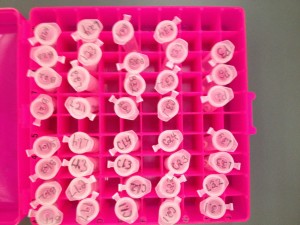
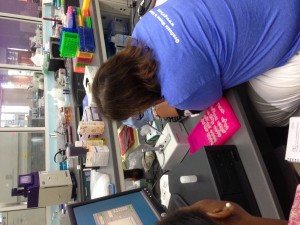
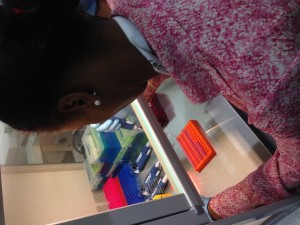
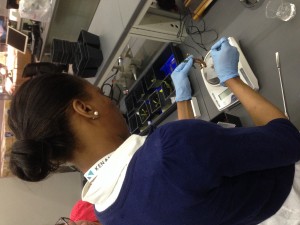
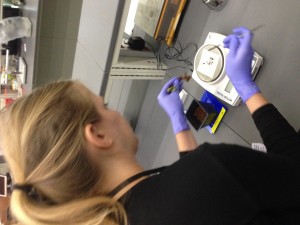
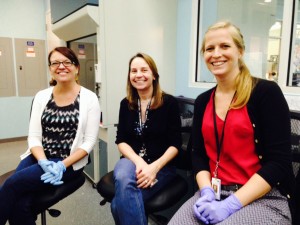
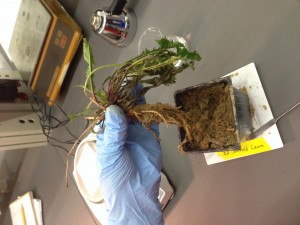 This is my last week in the Genomics lab. We started the day by taking all of our samples and measuring out 0.25 grams of the soil near the root (in two samples). In the third sample, we only dug near the root and did not uproot the dandelion plant. All of the plants were replanted and placed back under the grow lights. In the afternoon, we actually extracted DNA from two sets of our samples. This was amazing. We each worked with our mentors during this process. On Tuesday, we extracted DNA from our last four samples and tested the quality using the nano drop machine. The results were impressive and we will know more once we run our gels. We also performed PCR using the Earth Microbiome project. We will be sending our final samples along with samples from Dr. Urban’s plant hopper experiment to NCState to be analyzed. All of our samples willbe in one test tube but will be marked with alumina markers. We will get about 15 million copies for $1300. This is remarkable. In three years this could be $600. On Wednesday, we ran the gel for our 39 samples and did not notice any bands. Dr. Stevens decided to run the gel electrophoresis again with just five samples. We also plated nine soil samples on our four agar plates (nutrient, fungi soil, bacteria soil, and rose bangle agars). On Thursday, we worked on the curriculum in the morning and went to a lab meeting with our mentors. We were able to discuss how we would incorporate our project within our curriculum. We also ran another gel electrophoresis on eight samples. We had another lunch discussion with Liz Baird and the director of the museum. I am getting a little emotional about the fact that tomorrow is our last day. This experience has truly enriched my life in so many ways. I have enjoyed learning new laboratory techniques and procedures, working with my mentors, collaborating with Laura and Amy (and other Kenan Fellows), and working at the museum. I would love to be a mentor or in some other way to help the future Kenan Fellows! Friday amazing and sad at the same time. As my fellow Student Discover cohorts will agree, goodbyes are difficult. It is as if you are closing a chapter in your life. I would like to think the the museum, my mentors, my fellow Kenan members, and all of the people associated with my externship are part of my extended family. I will truly miss going to the museum each day and doing scientific research. It was nice to hear from my mentors that we are a part of the museum now and can return anytime. I had my face tested for mites and surprisingly, they were none. We also took pictures of our agar plates. There was a great deal of growth within the last 48 hours. In addition, Dr. Stevens gave a Daily Planet Talk on the lion fish. That was extremely interested. Lastly, we set up our last PCR. Well, I hope it is not my last PCR set up because I am on the volunteer list and would love to come back to do additional projects in the genomics laboratory. I cannot reiterate how fortunate I feel to be a part of the Kenan Fellow’s program. Working at the museum was a dream. I will also cherish the relationships and memories of this experience. It has been one of the best experiences of my life. Science is so awesome and the Kenan Fellow’s Program rocks!
This is my last week in the Genomics lab. We started the day by taking all of our samples and measuring out 0.25 grams of the soil near the root (in two samples). In the third sample, we only dug near the root and did not uproot the dandelion plant. All of the plants were replanted and placed back under the grow lights. In the afternoon, we actually extracted DNA from two sets of our samples. This was amazing. We each worked with our mentors during this process. On Tuesday, we extracted DNA from our last four samples and tested the quality using the nano drop machine. The results were impressive and we will know more once we run our gels. We also performed PCR using the Earth Microbiome project. We will be sending our final samples along with samples from Dr. Urban’s plant hopper experiment to NCState to be analyzed. All of our samples willbe in one test tube but will be marked with alumina markers. We will get about 15 million copies for $1300. This is remarkable. In three years this could be $600. On Wednesday, we ran the gel for our 39 samples and did not notice any bands. Dr. Stevens decided to run the gel electrophoresis again with just five samples. We also plated nine soil samples on our four agar plates (nutrient, fungi soil, bacteria soil, and rose bangle agars). On Thursday, we worked on the curriculum in the morning and went to a lab meeting with our mentors. We were able to discuss how we would incorporate our project within our curriculum. We also ran another gel electrophoresis on eight samples. We had another lunch discussion with Liz Baird and the director of the museum. I am getting a little emotional about the fact that tomorrow is our last day. This experience has truly enriched my life in so many ways. I have enjoyed learning new laboratory techniques and procedures, working with my mentors, collaborating with Laura and Amy (and other Kenan Fellows), and working at the museum. I would love to be a mentor or in some other way to help the future Kenan Fellows! Friday amazing and sad at the same time. As my fellow Student Discover cohorts will agree, goodbyes are difficult. It is as if you are closing a chapter in your life. I would like to think the the museum, my mentors, my fellow Kenan members, and all of the people associated with my externship are part of my extended family. I will truly miss going to the museum each day and doing scientific research. It was nice to hear from my mentors that we are a part of the museum now and can return anytime. I had my face tested for mites and surprisingly, they were none. We also took pictures of our agar plates. There was a great deal of growth within the last 48 hours. In addition, Dr. Stevens gave a Daily Planet Talk on the lion fish. That was extremely interested. Lastly, we set up our last PCR. Well, I hope it is not my last PCR set up because I am on the volunteer list and would love to come back to do additional projects in the genomics laboratory. I cannot reiterate how fortunate I feel to be a part of the Kenan Fellow’s program. Working at the museum was a dream. I will also cherish the relationships and memories of this experience. It has been one of the best experiences of my life. Science is so awesome and the Kenan Fellow’s Program rocks!
How I will incorporate my Kenan externship into my curriculum….
I have thought of ways in which I can incorporate my externship at the museum into my curriculum. In the fall, I will be teaching Common Cor Math 7 Plus and Math I. The seventh grade curriculum has two units dealing with ratios, proportions, and slope. I have already used proportions and ratios when creating mixtures. The data that is obtained from my soil experiment could be graphed and analyzed statistically.
There is a great deal of math used in a laboratory setting. Math is used to accurately measure out solitons and reagents. It is used when calibrating pipettes. I used scale and scale factor today when preparing my DNA sample for PCR. I used graphing when analyzing the strength of my DNA sample. My team talked with Dr. Urban about other ways to scale our soil project to our classrooms. We lack all of the fancy equipment from the Genomics lab at the Science Museum, we could have our students collect soil samples and send the in to the Genomics lab for analysis. My students could then Skype or video conference with my mentors, as the explained the process of analyzing the samples. My students could analyze real world problems dealing with changes in the concentrations of the solutions used(proportions) and graphing the data.
Amy and Laura’s classes will collect soil samples from their homes. They will also collect dandelions and plant the dandelions in the soil samples after sterilizing them. The samples will be sent to Dr. Stevens for analysis. My students will then create graphs and use other statistical measures to analyze the data.
Week 2: DNA Extraction and PCR(Polymerase Chain Reaction)
On Tuesday, July 8, 2014, I extracted my first sample of DNA and actually analyzed the quality of my sample using a nano drop machine. This machine graphs the absorbable of the DNA sample in millimeters vs. the wavelength in nanometers. I used 1.5 nano liters of my sample and had a concentration of 26.8 nano grams and a quality of 1.89. My mentor, Dr. Julia Stevens said this was excellent for my first DNA extraction. I also performed my first PCR on my DNA sample. PCR is used to copy DNA. We used a total of 8 samples, four for the bacteria mixture and four for the fungi mixture. There were also two negative controls. After created the mixture, we placed our tubes in the PCR machine. The pictures below some of these procedures.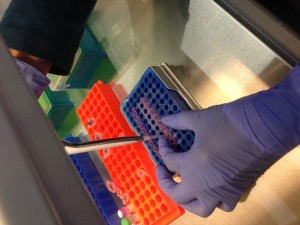
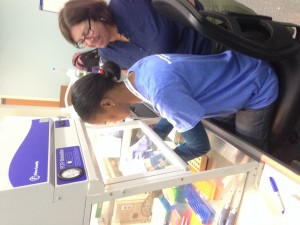
Week 2: July 7-11, 2014-The fun continues…
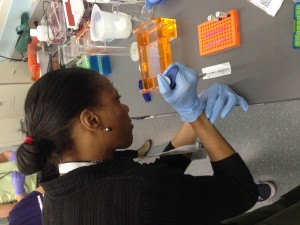
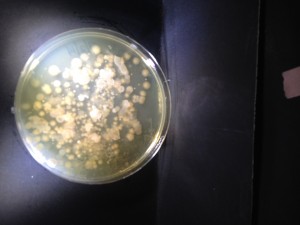
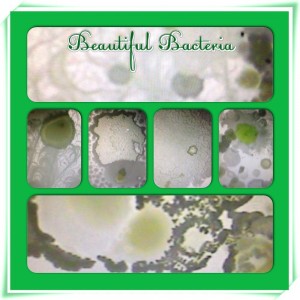





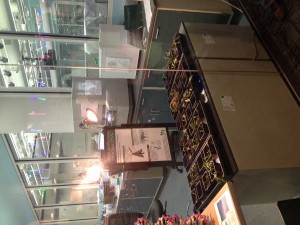

 Well, this is week two of my fellowship at the Natural Science Museum. I feel like a kid in a candy shop. I do not want my externships to end. On Monday, we will actually start collecting dandelions for our experiment. I arrived at work an hour earlier in order to finish our display. Our display highlights some cool things that we will be doing at the museum. I will be heading to Prairie Ridge at 9:00. We caught over 30 dragonflies and were totally excited. After lunch, we saw Dr. Duke in the Animal Lab perform a simple procedure on a black banded fish. She anesthetized fish by placing him a small tub of anesthesia. We also finished working on our first museum display and planted our dandelions in our soil samples. On Tuesday, we extracted DNA from samples collected last week and learned more about PCR. The DNA process was quite lengthy. On Wednesday, we completed our first gel electrophoresis. The process went well until we placed the gel into the gel imager and realized that the bands did not show up. What a bummer! Therefore, we have to re-do the PCR and gel electrophoresis tomorrow. We also created our first soil agar. My mentor said that they have never done this before in the Genomics Lab. This went extremely well. We used 200 g of soil, 400ml of ultra pure water, and auto cleaved for about 2 hours. Next, we used .50g of sugar, 0.1 g of potassium phosphate, 7.5 g of Bacto-agar, and 130 ml of the soil extract, and 370 ml of water. We created two agars( fungi and bacteria). This was autoclaved for another 2 hours. We also looked at our plated soil samples from last week.
Well, this is week two of my fellowship at the Natural Science Museum. I feel like a kid in a candy shop. I do not want my externships to end. On Monday, we will actually start collecting dandelions for our experiment. I arrived at work an hour earlier in order to finish our display. Our display highlights some cool things that we will be doing at the museum. I will be heading to Prairie Ridge at 9:00. We caught over 30 dragonflies and were totally excited. After lunch, we saw Dr. Duke in the Animal Lab perform a simple procedure on a black banded fish. She anesthetized fish by placing him a small tub of anesthesia. We also finished working on our first museum display and planted our dandelions in our soil samples. On Tuesday, we extracted DNA from samples collected last week and learned more about PCR. The DNA process was quite lengthy. On Wednesday, we completed our first gel electrophoresis. The process went well until we placed the gel into the gel imager and realized that the bands did not show up. What a bummer! Therefore, we have to re-do the PCR and gel electrophoresis tomorrow. We also created our first soil agar. My mentor said that they have never done this before in the Genomics Lab. This went extremely well. We used 200 g of soil, 400ml of ultra pure water, and auto cleaved for about 2 hours. Next, we used .50g of sugar, 0.1 g of potassium phosphate, 7.5 g of Bacto-agar, and 130 ml of the soil extract, and 370 ml of water. We created two agars( fungi and bacteria). This was autoclaved for another 2 hours. We also looked at our plated soil samples from last week.
On Thursday, we created our PCR samples and ran our gels again. We also learned about this cool program called MG -Rast. This programs is absolutely free and has on online repository or meta-genomes. It also allows for data analysis and has great visualizations for diversity. Every scientists that works on a project posts their data here. This is a great resource for teachers and students. Students could compare the soil in the Artic with the soil in Spain and create graphs and analyze the data statistically. Wow! We also made more soil agar, in preparation for next week’s analysis of our soil project! On Friday, we worked on writing curriculum and had a Skype discussion with Dr. Meg Lowman. She is a scientist at Cal Tech and helped to write the NSF grant for the Student’s Discover Project. We also had another lunch to discuss and summarize the week’s activities. In the afternoon, we plated more of of soil samples on four different types of agar. We also decided to run our experiment for a month, instead of just one week. Our dandelions really look good. I am truly sad that next week is my last week. I have enjoyed working in the Genomics lab with my mentors and with Laura and Amy. Our mentors are extremely patient and excellent teachers. I have also enjoyed collaborating with the other Kenan Fellows at the museum. This has been one of the best experiences of my life and I have signed up to volunteer after my fellowship ends. I also want to apply for the “Educator’s of Excellence Grant” to go to Belize or Ecuador next summer!



